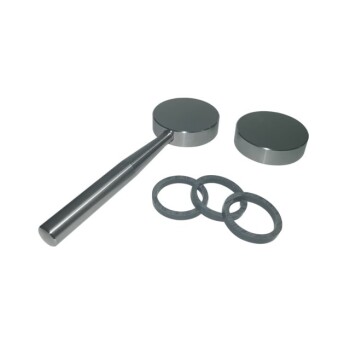XRF analysis using a portable XRF analyzer has shown significant improvements in efficiency and accuracy for materials analysis.
This analyzer can detect and quantify elements like Cr, Cu, and Mo with high stability, accuracy, and repeatability.
It is a primary tool for determining FAC in nuclear and fossil fuel power plants.
It is also ideal for quality control and grade identification of alloy materials.
The results are displayed on an LCD screen, showing a table of detected elements and their concentrations.
High-quality sample preparation, such as making pressed pellets, is crucial for achieving consistent and reliable analytical results.
5 Key Benefits of XRF Analysis You Need to Know

1. Improved Efficiency and Accuracy
The portable XRF analyzer significantly enhances the efficiency and accuracy of materials analysis.
It allows for timely detection of ingredient problems or changes in materials, enabling prompt adjustments and improvements to avoid production and quality issues.
2. Stable and Accurate Analysis
A low-alloy steel sample was tested 10 times under the same conditions, with each test lasting 30 seconds.
The repeatability test demonstrated that the analysis results are stable, accurate, and repeatable, indicating good reliability.
3. Versatile Application
The XRF 900 series handheld XRF analyzer has excellent trace element detection capabilities.
It can accurately measure the composition and content of alloy elements such as Cr, Cu, and Mo, making it comparable to spark optical emission spectrometers for FAC applications.
The analyzer can be used as the main analysis tool for FAC determination in nuclear and fossil fuel power plants.
It is ideal for quality control and grade identification of alloy materials.
4. User-Friendly Display
The results of the assay are displayed on a built-in LCD screen.
Typical results show a table listing all detected elements and their concentrations, providing a clear and concise overview of the analysis.
5. Non-Destructive Analysis
XRF is a non-destructive elemental analysis tool capable of identifying and quantifying elements in bulk materials.
It involves extracting a small sample volume from the uppermost surface layers or homogenizing a fragment as a fine powder for analysis.
Importance of Sample Preparation
Sample preparation is now the most significant source of error in XRF analysis.
High-quality sample preparation techniques, such as making pressed pellets, are crucial for achieving consistent and reliable analytical results.
This method is popular due to its quick, low-cost, and high-quality outcome.
Chemical Composition Analysis
The XRF analysis reports the chemical composition of materials, including elements like Si (quartz) and Ca (calcite).
The results indicate the content and percentage of dominant elements in the sample, such as Fe2O3, MgO, CaO, and SiO2.
Continue Exploring, Consult Our Experts
Transform your materials analysis game with KINTEK SOLUTION's XRF analyzer—efficiency and accuracy guaranteed!
Capture precise element readings like Cr, Cu, and Mo with unbeatable stability.
Ready for any challenge, from nuclear plant quality control to alloy grade identification.
Witness the clarity of your data on an intuitive LCD screen.
Don't settle for less. Enhance your operations today—contact KINTEK SOLUTION and unlock the full potential of your materials analysis.











